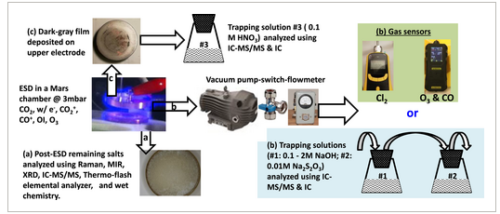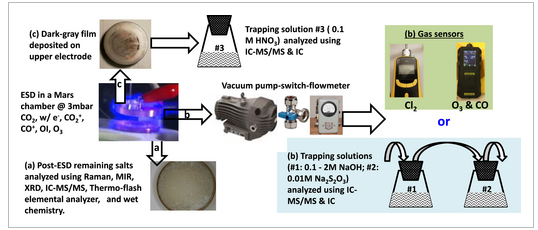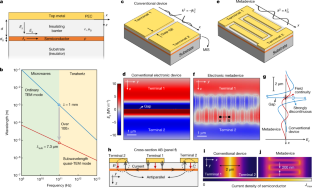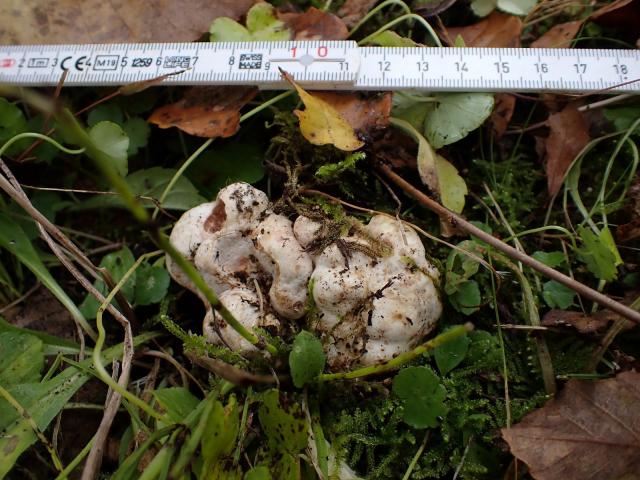火星の塩素循環の主要な原動力は放電である可能性 Electrical discharge could be major driving force of Martian chlorine cycle
2023-02-16 ワシントン大学セントルイス校
◆地球上のダストストームでは強い電場が発生するため、火星でも同じことが起こるのは当然かもしれません。しかし、次に何が起こるのでしょうか?おそらく、地球で予想されるような突然の稲妻ではないだろう。
◆ワシントン大学セントルイス校の惑星科学者アリアンワンは、火星での放電は、おそらくかすかな光に近いと見ている。(火星着陸機、探査機、その他のミッションのどれもが、その実像をとらえていないのだ)。
◆ワン教授の新しい研究は、『Geophysical Research Letters』誌に掲載され、砂嵐の電気が火星の塩素サイクルの主要な駆動力である可能性を示している。
◆背景として、科学者たちは、塩素を火星で「移動可能」な5つの元素(他の元素は水素、酸素、炭素、硫黄)のうちの1つとみなしている。つまり、塩素がさまざまな形で火星の地表と大気を行き来しているのです。地表には、地球上の塩類プラヤや浅い塩田に似た塩化物の堆積物が広がっています。これらの塩化物堆積物は、火星の初期の歴史において、塩水から塩化物塩が沈殿して形成されたと考えられる。
◆今回の研究で、Wang教授は、火星の地上から大気中への塩素の移動が、火星の塵の活動で生じる放電による反応によって、特に効率的に行われることを明らかにした。
◆王教授とその共同研究者たちは、火星に似た条件下で固体塩を放電させることにより、一般的な塩化物から高収率で塩素ガスを得る一連の実験を行った。この実験は、ワシントン大学の惑星シミュレーション室(Planetary Environment and Analysis Chamber、PEACh)を用いて行われた。
<関連情報>
- https://source.wustl.edu/2023/02/study-quantifies-global-impact-of-electricity-in-dust-storms-on-mars/
- https://agupubs.onlinelibrary.wiley.com/doi/10.1029/2022GL102127
火星塵の活動による不均一電気化学反応で生成された炭酸塩、オキシ塩素、塩素の定量化 Quantification of Carbonates, Oxychlorines, and Chlorine Generated by Heterogeneous Electrochemistry Induced by Martian Dust Activity
Alian Wang, Andrew W. Jackson, Neil C. Sturchio, Jen Houghton, Chuck Y. C. Yan, Kevin S. Olsen, Quincy H. K. Qu
Geophysical Research Letters Published: 24 January 2023
DOI:https://doi.org/10.1029/2022GL102127

Abstract
Heterogeneous electrochemistry induced by Martian dust activity is an important type of atmosphere-surface interaction that affects geochemical processes at the Martian surface and in the Martian atmosphere. We have experimentally demonstrated that heterogeneous electrochemistry stimulated by mid-strength dust events can decompose common chloride salts, which is accompanied by the release of chlorine atoms into the atmosphere and the generation of (per)chlorates (chlorates and perchlorates) and carbonates. In this study, we present quantitative analyses on the above products from 26 heterogeneous electrochemical experiments on chloride salts. Based on these quantifications, our calculation indicates that such atmosphere-surface interaction during a portion of Amazonian period could accumulate the observed abundance of (per)chlorates, carbonates, and HCl by landed and orbital missions, and thus can be considered as a major driving force of the global chlorine-cycle on Mars. This study emphasizes the importance of measuring the electrical properties of dust activity on Mars.
Key Points
- Heterogeneous electrochemistry induced by Mars dust activity can decompose chloride, form (per)chlorate, carbonate, and release chlorine
- This experimental study simulated mid-strength Mars dust events and revealed the high yields of (per)chlorates, carbonates, and chlorine
- A calculation based on the results supports Martian dust activity as the major driving force for the global Cl-cycle in Amazonian period
Plain Language Summary
Frictional electrification is a common process in our solar system, with Martian dust activities known to be a powerful source of electrical charge buildup. Furthermore, the thin atmosphere on Mars makes the breakdown of accumulated electrical fields, in form of electrostatic discharge (ESD), much easier to occur (a hundred times easier than on Earth). ESD generates a huge amount of energetic electrons that collide with Martian atmospheric molecules and generate free radicals. These free radicals react with the Martian chlorides to generate new species. This study found the yields of (per)chlorates, carbonates, and chlorine from the ESD process, with the strength matching mid-strength Martian dust activity, are at per thousand or percent levels (normalized to the starting chlorides). Based on these results, it is possible to calculate the total yields of those species produced from known chloride sources on Mars by global dust storms during defined durations in the Amazonian period. It was found that the contributions of Mars dust activity can account for the abundances of (per)chlorates, carbonates, and chlorine observed by past and current Mars missions. This study supports that Martian atmosphere-surface interaction in dust events is a major driving force for the global chlorine-cycle on Mars.




